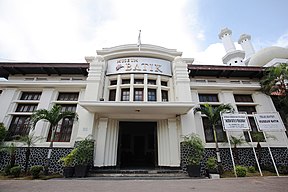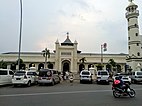Pekalongan
This article includes a list of general references, but it lacks sufficient corresponding inline citations. (June 2011) |
Pekalongan | |
|---|---|
| Other transcription(s) | |
| • Hanacaraka | ꦥꦼꦏꦭꦺꦴꦁꦔꦤ꧀ |
| • Pegon | ڤٓكالَوڠان |
| • Chinese | 北加隆岸 Běi jiā lóng àn (Pinyin) |
Clockwise, from above : Pekalongan Batik Museum, Al-Jami' Grand Mosque, Pekalongan Fish Harbour, Pekalongan Post Office, Indonesia Christian Church of Pekalongan | |
| Nickname: Kota Batik (lit. 'the Batik city') | |
| Motto(s): Pekalongan Kota BATIK (Bersih (Clean), Aman (Safe), Tertib (Discipline), Indah (Beautiful), Komunikatif (Communicative)) | |
 Location within Central Java | |
| Coordinates: 6°53′S 109°40′E / 6.883°S 109.667°E | |
| Country | |
| Province | |
| Government | |
| • Mayor | Achmad Afzan Arslan Djunaid |
| Area | |
| • Total | 45.25 km2 (17.47 sq mi) |
| Population (mid 2023 estimate)[1] | |
| • Total | 317,524 |
| • Density | 7,000/km2 (18,000/sq mi) |
| Time zone | UTC+7 (Western Indonesia Time) |
| Area code | (+62) 285 |
| Website | pekalongankota.go.id |
Pekalongan (Javanese: ꦦꦼꦏꦭꦺꦴꦔꦤ꧀) is a city of Central Java, Indonesia. It was formerly the seat of Pekalongan Regency on the northern coast of the province, but is now an independent municipality within the province. It covers a land area of 45.25 km2 and had a population of 281,434 at the 2010 Census[2] and 307,150 at the 2020 Census;[3] the official estimate as at mid 2023 was 317,524 (comprising 160,369 males and 157,155 females).[1] The city is Central Java's most important port, and is known for its batik. Since December 2014, Pekalongan has been a member of UNESCO's World's Creative Cities Network, the first Southeast Asian city to be added to the list.[4]
The Dutch name of the city is 'Pacalongan'.
History
[edit]The coastal area around Pekalongan was part of the ancient Holing (Kalingga) kingdom. The 7th century Sojomerto inscription, discovered in neighboring Batang Regency, Central Java, is linked with Kalingga as well as the ancestor of the Sailendras. The exact location of the Kalingga capital is unclear. It has been suggested that it was somewhere between Pekalongan and Jepara; however it is most likely that it was located in Pekalongan, rather than Jepara, since there is similarity of names between Kalingga and Pekalongan. The name probably slightly shifted over centuries, from Kalingga, Kaling, Kalong, and later added with pe- -an circumfix forming "Pekalongan".
The history of Pekalongan dates back to the early 12th century. A book written in 1178 by a Song dynasty official already had a record of Pekalongan, then known to Chinese merchants as "Pukalong". It was then a seaport of Java (then known as Dvapa). The king of Java lived at Pukalong - he knotted his hair at the back of his head, while his people had short hair and wrapped their body with colorfully woven cloth. A Chinese merchant ship set sail from Canton during November, and with the aid of fair winds sailed nonstop day and night, arriving at Pukalong after about one month. The people made wine from coconuts, and produced delicious red and white cane sugar. The kingdom made coins out of bronze and copper, with 60 copper coins exchanged for one tael of gold. Local produce included pepper, clove, sandalwood, eaglewood and white round cardamom.[5]
Pekalongan became a part of the empire of the Sultanate of Mataram through treaties and marriage alliances by the early 17th century. The area was on the geographic periphery of the empire, which was based in interior central Java. However, it was a wealthy area, and by the end of the 17th century, the substantial money and produce it sent to the center made it a key part of Mataram's realm. The area went into economic decline during the 18th century, and the Dutch East India Company began to gain substantial influence over the area's political and economic life. The Dutch built a fort in the city in 1753; this fort still stands.

From the 1830s, the Pekalongan area became a major producer of sugar. Sugarcane had been grown in the area since the early 12th century, as recorded in Chinese history books, but production expanded substantially during the mid-19th century due to Dutch efforts. Initially, production was boosted through compulsory corvée labor. The Dutch colonial government took advantage of longstanding Javanese expectations that the peasantry contribute a part of their labor to the state. Between the 1860s and the 1890s, this system was phased out, and workers were paid directly. The colonial sugar industry collapsed during the Great Depression of the 1930s, but sugar remains a key export of the area in independent Indonesia.
On October 8, 1945, an anti "Swapraja"/anti feudalism movement called Three Regions Movement/"Gerakan Tiga Daerah" was established in Tegal, Pekalongan, and Brebes. The goal of this movement was to replace the blue blood regents (related to the kings from Jogyakarta and Surakarta) with ordinary people. According to the leaders of this movement, the old regents had cooperated with Japanese during World War II and sent people to Japanese slave labor camps.
The main leader of this movement was Sarjiyo, who became the new regent of Pekalongan. Other leaders of this movement were Kutil, K. Mijaya, and Ir. Sakirman. Ir Sakirman was the local leader of Indonesian Communist Party (PKI).
The old regents were arrested, stripped naked, and dragged into the prisons. Other government officials and police officers were kidnapped and massacred at Talang bridge. This movement also started a racial riot against ethnic Chinese in Brebes.
The government of Republic of Indonesia in Jogyakarta disagrees with this movement and declared it was illegal. On November 4, 1945, the movement attacked Indonesian army HQ and the regent's office in Pekalongan. The rebels were defeated by Indonesian army in a fierce battle on December 21, 1945. Most leaders of this movement were arrested and thrown into the prisons. This rebellion is known as the Three Regions Affair.
Geography
[edit]Pekalongan city extends between 6º50’42"–6º55’44" South latitude and 109º37’55"–109º42’19" East longitude. The farthest distance from north to south is ± 9 km, and west to east is ± 7 km. The administrative borders of Pekalongan city are:
| North | Java Sea |
| South | Pekalongan Regency and Batang Regency |
| West | Pekalongan Regency |
| East | Batang Regency |
Climate
[edit]Pekalongan has a tropical rainforest climate (Af) with moderate rainfall from June to October and heavy to very heavy rainfall from November to May.
| Climate data for Pekalongan | |||||||||||||
|---|---|---|---|---|---|---|---|---|---|---|---|---|---|
| Month | Jan | Feb | Mar | Apr | May | Jun | Jul | Aug | Sep | Oct | Nov | Dec | Year |
| Mean daily maximum °C (°F) | 29.4 (84.9) |
29.7 (85.5) |
30.6 (87.1) |
31.3 (88.3) |
31.5 (88.7) |
31.6 (88.9) |
31.8 (89.2) |
32.0 (89.6) |
32.6 (90.7) |
32.5 (90.5) |
31.5 (88.7) |
30.5 (86.9) |
31.3 (88.3) |
| Daily mean °C (°F) | 25.5 (77.9) |
25.8 (78.4) |
26.5 (79.7) |
27.0 (80.6) |
27.1 (80.8) |
26.7 (80.1) |
26.5 (79.7) |
26.5 (79.7) |
27.1 (80.8) |
27.3 (81.1) |
26.9 (80.4) |
26.2 (79.2) |
26.6 (79.9) |
| Mean daily minimum °C (°F) | 21.7 (71.1) |
21.9 (71.4) |
22.4 (72.3) |
22.7 (72.9) |
22.7 (72.9) |
21.8 (71.2) |
21.2 (70.2) |
21.0 (69.8) |
21.6 (70.9) |
22.1 (71.8) |
22.3 (72.1) |
22.0 (71.6) |
22.0 (71.5) |
| Average rainfall mm (inches) | 572 (22.5) |
408 (16.1) |
283 (11.1) |
151 (5.9) |
144 (5.7) |
84 (3.3) |
93 (3.7) |
87 (3.4) |
80 (3.1) |
104 (4.1) |
147 (5.8) |
295 (11.6) |
2,448 (96.3) |
| Source: Climate-Data.org[6] | |||||||||||||
Administrative districts
[edit]Pekalongan city is divided into four districts, listed below with their areas and their populations as of 2010[2] and 2020[3] Censuses, together with the official estimates as at mid 2023.[1] The table also includes the number of administrative villages (all classed as urban kelurahan) in each district, and their post codes.
| Kode Wilayah |
Name of District (kecamatan) |
Area in km2 |
Pop'n Census 2010 |
Pop'n Census 2020 |
Pop'n Estimate mid 2023 |
No. of villages |
Post codes |
|---|---|---|---|---|---|---|---|
| 33.75.01 | Pekalongan Barat (West Pekalongan) |
9.70 | 88,732 | 94,829 | 97,191 | 7 | 51111-51113, 51116-51117 (a) |
| 33.75.02 | Pekalongan Timur (East Pekalongan) |
9.26 | 62,611 | 68,750 | 70,226 | 7 | 51122-51124, 51127-51129 |
| 33.75.03 | Pekalongan Utara (North Pekalongan) |
10.89 | 55,069 | 65,176 | 69,810 | 6 | 51141, 51143, 51146-51149 |
| 33.75.04 | Pekalongan Selatan (South Pekalongan) |
15.40 | 75,022 | 78,395 | 80,944 | 7 | 51132-51135, 51138-51139 |
| Totals | 45.25 | 281,434 | 307,150 | 317,524 | 27 |
Note: (a) except the kelurahan of Tirto, which has a post code of 51151.
Transportation
[edit]Pekalongan is a road and rail crossing point between Jakarta and Surabaya. Pekalongan is connected to the Trans-Java Expressway by the Pemalang-Batang Toll Road. All passenger trains from west or east stop at Pekalongan train station.
Tourism Places
[edit]Pekalongan has many tourism places, such as:
- Batik Museum
- Kauman Batik Tourism Village
- Pesindon Batik Tourism Village
- Medono ATBM (Non Automatic Weaving Machine) Tourism Village
- Landungsari Canting Tourism Village
- Pasir Kencana Beach
- Slamaran Indah Beach
- Pekalongan Mangrove Park
- Heroes Monument
- Jetayu Culture Area
Business
[edit]The city is known for its batik. The dyed fabric is produced both by hand in small-scale businesses, and is printed in larger factories. A mainstay of the economy, the industry collapsed during Indonesia's economic crisis in 1998, but it has partially recovered since. Pekalongan has many business and industries, such as :
- Traditional (wood) and Modern (fiberglass) Shipyard
- Small-scale batik industries
- Small-scale snack industries
- Fishing Port
- Fish canning factory
- Shopping mall
- Luxury Hotels
Prominent inhabitants
[edit]- George Junus Aditjondro, (1946-2016), sociologist
- Beb Bakhuys, (1909-1982), Dutch football player and manager
- Maria Dermoût (1888-1962), Indo novelist
- Hartono Rekso Dharsono, (1925-1996), first Secretary General of ASEAN
- Abdul Rahman Saleh, (1941-), former Attorney General of Indonesia
- Hoegeng Iman Santoso, (1921-2004), (former Chief of the Indonesian National Police)
- Thio Tjin Boen, (1885-1940), novelist
- Joe Hin Tjio, (1919-2001), scientist
- Muhammad Ridho Djazulie, (1992-..), Indonesian professional footballer
Sources
[edit]- Knight, G.R. (1995) Gully Coolies, Weed-Women and Snijvolk: The Sugar Industry Workers of North Java in the Early Twentieth Century. Modern Asian Studies 28(1):51-76.
- Ricklefs, M.C. (1986) Some Statistical Evidence on Javanese Social, Economic and Demographic History in the Later Seventeenth and Eighteenth Centuries. Modern Asian Studies 20(1):1-32.
Gallery
[edit]-
Pekalongan harbour (ca.1933-40)
-
A large residence in Pekalongan used by the "Captain of The Arabs"
-
Former emblem of Pekalongan City used from 2014, after negative response the logo was reverted in 2017.[7]
References
[edit]- ^ a b c Badan Pusat Statistik, Jakarta, 28 February 2024, Kota Pekalongan Dalam Angka 2024 (Katalog-BPS 1102001.3374)
- ^ a b Biro Pusat Statistik, Jakarta, 2011.
- ^ a b Badan Pusat Statistik, Jakarta, 2021.
- ^ "Wonderful Indonesia - Pekalongan: first Indonesian city included in UNESCO's World Creative Cities Network". www.indonesia.travel. Archived from the original on 2015-09-24. Retrieved 2015-08-16.
- ^ Song dynasty Zhou Qufei: Ling Wai Dai Da (Reports from Beyond the Southern Mountains) in Chinese ISBN 7-101-01665-0. Unfortunately no English translation available, the above paragraph is my GFDL translation
- ^ "Climate: Pekalongan". Climate-Data.org. Retrieved 12 November 2020.
- ^ "Logo Baru Tapi Lama Kota Pekalongan Diluncurkan". Warta Desa.












![Former emblem of Pekalongan City used from 2014, after negative response the logo was reverted in 2017.[7]](http://upload.wikimedia.org/wikipedia/commons/thumb/2/2f/Logo_kota_pekalongan.png/120px-Logo_kota_pekalongan.png)
